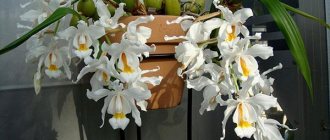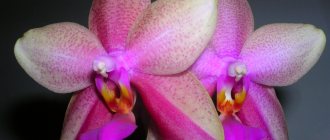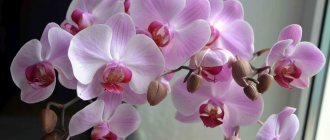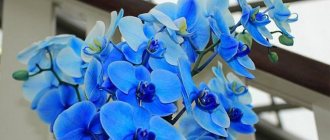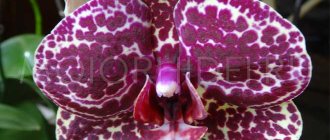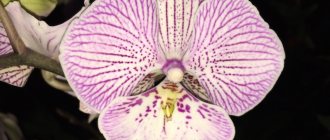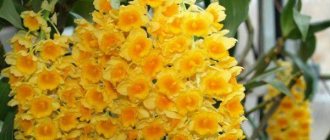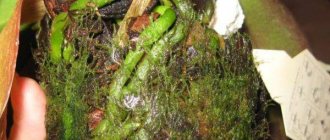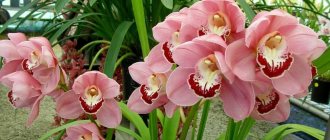Types of coelogina
In the culture of European floriculture, out of more than a hundred species, several of them have been cultivated, which are most suitable for growing at home. Coelogyne cristata (lat. Coelogyne cristata). It has two evergreen leaves at the base of the bulb and large flowers, reaching up to 10 cm in diameter, collected in a raceme inflorescence.
Drooping coelogyne (lat. Coelogyne flaccida). The plant is characterized by cream-sand-colored inflorescences with medium-sized flowers, up to 5 cm in diameter.
Coelogyne massangeana (lat. Coelogyne massangeana). This species has the longest inflorescence, pale yellow in color with a characteristic sweetish odor and small flowers.
Botanical description
Coelogyne (lat. Coelogyne), belongs to the Orchid family (lat. Orchidaceae) and is an epiphytic or terrestrial flowering perennial plant.
On one rhizome the stems are densely or more loosely arranged. They can have a glossy or matte surface. Their shape can be oval, cylindrical or disc-shaped with a ribbed or smooth structure.
On the stems there are linear leaves located in pairs or singly, which are narrowed towards the base. Peduncles emerge from the tops of the stems or their bases. Multi-flowered inflorescences are drooping.
Lighting and temperature
Coelogina is a light-loving plant. If you place it in the northern part of the house, then flowering will most likely become a rare occurrence for this orchid. There should be a lot of light, bright and diffused.
Direct sunlight, especially on a hot day, can seriously damage the leaves and inflorescences of the plant. Therefore, on hot days of summer, it is advisable to shade the plant.
Temperature has less of an impact on flower development, but still. The average value for comfortable growth of cellulina should be +22+24°C. Cooler conditions will also suit the plant, but temperatures below +15 °C may adversely affect the rate of growth and development of flower arrows.
Humidity and watering
Humidity for celogina , as for most orchid species, should be moderately high. An indicator of up to 70% will be favorable for the plant. Like any plants, celogina can also experience a significant decrease in this indicator, which with prolonged exposure can affect the overall healthy appearance of the flower.
Watering tselogina should be done moderately. During the active growing season - more intensively. For irrigation, use water at room temperature, settled or soft. Stagnation of water in the pan will lead to rotting of the bulbs. Therefore, they take care of good drainage in advance.
In winter, tselogina is watered much less frequently.
Tselogina drooping
Growth:
Nepal, Sikkim, Darjeeling district in West Bengal, Bhutan, Lushai mountains in northeast India, Burma, Laos and Yunnan province in southwest China. In India, these orchids are found in mixed forests at an altitude of 1000–1800 m. In China they grow on trees and on rocks at an altitude of 1600–1700 m.
Climate in natural habitats:
- Fixed temperature range from +4°C to +31°C.
- Average humidity is 90–95% in summer and 75% in late winter.
- Precipitation from 8 mm. in December up to 798 mm. in July.
- Average temperatures (day/night) in summer +24–25°C/+20–21°C, in winter +14–16°C/+8–9°C.
Description of the plant:
Plant size and type:
Quite a large epiphyte or lithophyte, reaching a height of 42 cm.
Pseudobulbs:
Pseudobulbs are 5–12 cm high. They are narrow, fusiform or cone-shaped, clustered on the rhizome. At the base, the pseudobulbs are covered with large fibrous brown-black scales that fall off over time.
Leaves:
On each pseudobulb grows a pair of pointed, lanceolate, shiny, leathery leaves up to 30 cm long and 2–3 cm wide.
Peduncle:
An arched or hanging peduncle 25 cm long grows at the base of the youngest mature pseudobulb.
Flowers:
The peduncle bears up to 9 spectacular, simultaneously blooming flowers with a diameter of 3.5–4 cm. They are waxy, with a strong but unpleasant odor, and last a long time in cool and shaded conditions. All elements of the flower are white. The pointed lanceolate sepals are usually prostrate, although their tips may be slightly bent. Petals are oblong, blunt-pointed, bent. The lip is three-lobed. Its lateral lobes are straight with rounded apices and decorated with red stripes on the inside. The middle lobe is ovoid or lanceolate, golden yellow in the center, with a sharp, curved tip. Three waxy ridges with orange-brown tops stretch from its base to the middle.
Flowering period: from December to May with a peak in March.
Agricultural technology:
Temperature:
In summer, the average daytime temperature is +24–25°C, night temperature +20–21°C with a daily difference of 4–5°C. Where this species grows in China, maximum daily temperatures are 3°C higher, resulting in a larger diurnal difference.
Lighting:
18000–30000 lux. The light should be slightly diffused or filtered, and direct sun should be avoided. Constant ventilation is required.
Watering:
From late spring to autumn precipitation is very heavy. Then the average precipitation drops sharply and a dry period begins, which lasts until spring. Cultivated plants should be watered abundantly during the period of active growth, but the substrate around the roots should be well ventilated and should not be soggy or caked. When new growths reach maturity in the fall, reduce the amount of water.
Fertilizer:
During the growing season, it is recommended to feed the plants weekly with 1/4–1/2 dose of orchid fertilizer. You can use a balanced fertilizer throughout the growing season, or you can use a fertilizer with a high nitrogen content from spring to mid-summer, and then until the end of autumn - a fertilizer with a high phosphorus content. Salinization of the substrate can cause blackening of the ends of the leaves. To avoid this, you need to regularly rinse the substrate, especially if hard water is used for irrigation.
Substrate:
This orchid can be grown on blocks of cork or tree fern if high humidity and repeated watering throughout the day in summer can be provided. Since this watering regime is difficult for many lovers, these orchids are also grown in flat pots or baskets. Ordinary flower pots are deeper than necessary; after watering, the substrate in them remains wet for a long time, which Tselogins do not tolerate. Mesh baskets with 6 mm mesh or small bowls lined with sphagnum or coconut fibers have proven themselves to be excellent. The substrate should be loose and quick-drying, but at the same time retain some moisture. Such a substrate can be tree fern fibers with the addition of 10% fine charcoal, 10% perlite or porous rocks and 10% sphagnum. At appropriate temperatures, the correct watering schedule and strong ventilation, plants can be watered abundantly, since this substrate does not get wet, but at the same time does not dry out completely between waterings. Fern fibers do not decompose as quickly as bark, which means that too frequent replantings are not necessary.
If the orchid has grown from a pot, then it is transferred to a larger one along with the lump, without disturbing the root system. This is important because many Coelogins do not tolerate root manipulation well and sometimes remain ill for a year or even longer after transplanting or dividing. If replanting is still necessary, it is carried out only when new roots begin to grow, which will allow the plant to quickly take root.
Air humidity:
Humidity ranges between 90–95% in summer and early fall before dropping to 80% in late fall and early winter. For one month at the end of winter or beginning of spring, the humidity drops to 75%. However, in southwest China, the average humidity in summer is 75–80%, then gradually decreases to 60–65% in late winter and spring.
Rest period:
In winter, the average daytime temperature is +14–16°C, night temperature +8–9°C with a daily difference of 7°C.
In China, daytime temperatures in winter are 4–5°C higher, resulting in a greater difference between day and night temperatures. In nature, during 4–5 winter months there is little precipitation, but for most of this period additional moisture comes with fog, drizzle and heavy dew. In winter, the amount of water for plants is reduced. The substrate should dry out between waterings, but the plants should not remain dry for too long. Feeding is reduced or stopped completely until new growth appears and abundant watering begins in the spring. A cool, dry dormant period is very important for the health and flowering of Coelogina. Editorial team LePlants.ru
Soil and fertilizers
To transplant celogina, you need soil corresponding to the species that is cultivated at home. If it is an epiphyte, then the substrate is prepared from:
- sawdust (2 parts);
- charcoal (1 part);
- sphagnum moss (1 part).
For terrestrial species , celogins add the following components to the substrate:
- high peat (2 parts);
- sawdust (1 part);
- charcoal (1 part);
- river sand (1 part).
In any case, the soil or substrate for celogina should be light, loose, drained, and have good permeability to air or water. Fertilize the plant once a month with organic complex fertilizers for orchids. The dosage is selected according to the manufacturer's recommendations. In winter, feeding is stopped.
About caring for the celogina orchid at home
Temperature: °C ° Coelogina orchid feels good at normal room temperatures of 20-25 °C. In summer, it is recommended to move the orchid to the balcony, where the plant will receive maximum light and a natural change in day and night temperatures. In winter, the plant should be protected from cold drafts and kept at a stable, moderate temperature.
Lighting: Should be bright and diffused. It can be grown on south-facing windows, but in summer, at very high temperatures, it is recommended to shade it from midday, scorching sun rays. This orchid is also suitable for windows with eastern and western orientation. In summer, it is recommended to move the plant to a balcony, where the plant will receive maximum light and a natural change in day and night temperatures. It is very important to provide the orchid with intense lighting during the formation of young bulbs and the formation of flower buds. Daylight hours should be no shorter than 12-14 hours.
Watering: The soil in the pot should have time to dry completely, strong stagnation of moisture, waterlogging harms the orchid. When watering, moisture should not fall on the foliage. The frequency of watering depends on the temperature of the content. Watering is carried out only after the soil is completely dry. The surface of the soil in the pot is covered with damp sphagnum moss, which is regularly moistened - it is designed to reduce the evaporation of moisture from the substrate.
Watering is carried out with filtered or well-settled water. To water, the pot is lowered into a basin or bucket of water for 30 minutes so that the substrate is completely saturated with moisture. After watering, place the pot in an empty basin and wait for the excess water to drain.
With the beginning of the dormant period, the frequency of watering is reduced. When a peduncle appears, watering is resumed.
Coelogyne cormbosa. ©Yercaud-elango
Air humidity: Depends on the temperature of the content. In summer, the plant needs high air humidity, frequent daily spraying is necessary, and air humidifiers can also be installed. In winter, it is very important to keep the orchid as far as possible from heating systems, otherwise they can cause irreparable harm to the plant. A very important condition for growing this orchid is the flow of fresh air - the higher the humidity level, the more often there should be ventilation. In winter, the humidity level is lowered as the temperature drops.
Experienced gardeners recommend giving the orchid a warm shower from time to time, which has a beneficial effect on the appearance of young shoots and the frequency of flowering.
Fertilizers : Fertilize the plant with a special mixture for orchids in a concentration weaker than indicated on the package on average once a week. Root fertilizer is alternated with leaf fertilizer, but the concentration should be even weaker compared to the irrigation solution.
Fertilizers are diluted in a reduced dosage than what is written on the package, since the root system of this orchid is very sensitive to soil salinity. It is recommended to alternate root and foliar feeding from time to time. For foliar applications, the fertilizer solution should be even weaker than for root applications. During flowering, the number of fertilizer applications is reduced to 1 time per month.
Pests: Most often, celogina is attacked by spider mites .
Coelogyne chloroptera. ©snotch
Reproduction
Celogina is propagated vegetatively by dividing rhizomes. In the spring, daughter plants are separated from the mother plant so that the new bush contains from 1 to 5 bulbs. New plants are carefully transplanted into a substrate or moistened soil. Care is the same as for adult plants.
Read about how to care for a stone rose here.
Asparagus sprenger requires simple care at home. Find out more about this.
Let's grow asparagus pinnately from seeds simply. Useful tips https://sad-doma.net/houseplants/trava/asparagus/asparagus-peristyj.html for gardeners.
GENERAL INFORMATION:
In nature, Coelogyne flaccida is found in the Himalayas, Myanmar, China, Thailand, Vietnam, Burma and Laos, where it grows both epiphytically on trees and lithophytically on humus accumulations at an altitude of 900 to 2,300 meters above sea level. Pseudobulbs are bifoliate, conical to cylindrical in shape, ranging in size from 3 to 12 cm long and 1 to 4 cm wide, growing on a thick rhizome close to each other, covered below with dry lower leaves (about 4 cm long). The leaves are leathery, narrow, elliptical in shape, with pointed tips, with three veins, from 5 to 20 cm long and from 1 to 5 cm wide, sitting on a stalk (2-4 cm). The peduncle is pendulous, appears as separate shoots at the base of a fully formed pseudobulb, reaches a length of up to 30 cm. There are from 3 to 10 flowers per peduncle, which open almost simultaneously. The flowers are fragrant (unpleasant smell), creamy-white, star-shaped, 4-5 cm in diameter, have dry protective scales (about 2 cm long), which fall off long before the flower opens. Sepals are narrow, elliptical, with pointed tips, measuring 1.5-2.5 cm long and 0.5-1 cm wide. Petals are straight or curved back, also with pointed tips and also 1.5-2.5 cm long, but only 0.2 cm wide. The lip is triple, 1.5-2.5 cm long, its lateral parts are rounded, straight, covered inside with red-brown veins, and the front part of the lip is oval in shape, with a pointed tip, at the base it is red-brown (often with golden veins). ) spot. The column is straight, up to 1.5 cm in length.
Coelogyne flaccida varies slightly in the form of flowers; among the natural colors we can distinguish:
- Coelogyne flaccida var.
crenulata - has small denticles between the middle and front part of the lip; - Coelogyne flaccida var.
elegans - flowers are larger, almost odorless, the lip is not divided into parts;
in the last 15 years it has been marketed under the name Coelogyne elegans
.
Coelogyne huettneriana is also sold as Coelogyne elegans .
Synonyms for this type of orchid are: Coelogyne esquirolii and Pleione flaccida.
TEMPERATURE:
The adherence of a given type of orchid to a particular temperature regime largely depends on the specific area in nature in which its ancestors grew, so for plants whose growing location was 900-1,300 meters above sea level, a mixed temperature regime is suitable - warm summer, cold winter and a large difference between night and day temperatures, for plants growing at an altitude of 1,300 to 1,800 meters above sea level, a moderate or moderately cold regime (also with strong cooling at night), and for plants whose ancestors grew high in the mountains (1,800-2,300 meters), a cold temperature regime is needed, such plants do not tolerate temperatures above 20-22 °C very well. Since nowadays, when buying an orchid, you are unlikely to be clearly told the full pedigree of the plant, you will have to find out its temperature preferences experimentally. Just purchased Coelogyne flaccida can be placed at normal room temperature and observed, and if the orchid refuses to bloom under this condition, then apply colder sanctions to it. The general temperature of the content may vary:
Day:
16-30 °C (ideally no higher than + 24 °C);
Night:
+ 16 °C.
To successfully grow Coelogyne flaccida at home, it is necessary that the night temperature is always at least 6-12 °C lower than the daytime temperature. For example, if during the day it is + 28 °C, then at night it is no more than 16-22 °C. For many representatives of this species, the rule applies: “Whatever the daytime temperature, at night it should drop to + 16 °C.”
LIGHT:
Coelogyne flaccida loves bright sunlight and is able to tolerate direct sunlight (up to 50,000 Lux), sometimes acquiring a yellowish-green tint on older leaves. As a location, southern and western windows are ideal, eastern windows are a little worse, and the use of northern windows is highly undesirable, since sunlight here for regular flowering of orchids is usually insufficient and in addition to natural lighting you will have to use artificial light lamps [read more about lighting of orchids...]. Bright sunlight is one of the main prerequisites for the flowering of orchids of this type, and if the lighting is insufficient (especially during active growth), then the orchid simply will not bloom, since new shoots grow underdeveloped, i.e. incapable of flowering. Throughout the year, the duration of daylight should be at least 10 hours, ideally 16 hours. When caring for a plant, it is also advisable to use a combination of windows, for example, in autumn and winter there are southern and western windows, and in spring and summer - eastern and southeastern windows.
SUBSTRATE:
Since orchid flower stalks are usually drooping, plants are grown mainly in hanging pots, baskets [read more about making baskets...] or with a bare root system - placed on blocks. The substrate must be both very breathable and moisture-absorbing, so a mixture of coniferous tree bark (Italian Pinia pine) with charcoal, tree fern roots, humus and sphagnum moss (up to 50%) is best suited for its quality. When growing orchids on blocks, to prevent the root system of the plant from drying out quickly, it is recommended to make a small layer of moss between it and the block. You can also put live or dry sphagnum on top of the roots. As practice has shown, the plant feels best in wicker or lattice baskets (even when using only sphagnum), which provide good ventilation and prevent the substrate from drying out more quickly (than on blocks).
TRANSFER:
Coelogyne flaccida reacts quite negatively to transplantation and may subsequently miss 2-3 flowerings, i.e. form pseudobulbs that do not produce flowers, therefore it is advisable to replant the orchid only when it is really necessary, for example, in cases of severe salinity or compaction of the substrate, when its pH is critically high or low (the norm is from 5.5 to 6.5) or, when the plant grows very much and the pot becomes too small for it (the pseudobulbs will begin to hang over the edges of the pot). The best time for replanting is the period when new young orchid shoots begin to grow their own roots.
AIR HUMIDITY:
In places where Coelogyne flaccida grows (India, China, etc.), relative air humidity rarely drops below 70%. However, we should not forget that in nature the orchid grows with a bare root system, entwining moss-covered tree branches without penetrating into their bark, therefore, it is due to the high vapor content in the air that the main absorption of moisture occurs (containing roots in good shape) in periods when there is no rain. When growing orchids in substrates, their root system is in a moist state almost all the time, so the need for high air humidity around the plants is significantly reduced, and in many cases even harmful, causing rotting of not only the roots (which do not have time to dry out), but also the bases of the pseudobulbs.
The plant is designed in such a way that during its “life activity” it not only absorbs the moisture necessary for growth and development, but also evaporates it from the surface of the leaves and pseudobulbs. The dominant influence on this process is provided by sunlight, under the influence of which the orchid heats up and the rate of “sweating” increases. At temperatures from 18 to 28 °C and regular watering, this process proceeds in a completely normal, natural way - as much water has evaporated, the same amount has been absorbed by the roots, etc. At higher temperatures, the rate of water absorption slows down, and when the thermometer reaches + 35 °C, it almost stops completely. However, with all this, the active evaporation of moisture from the surface of the leaves not only continues, but picks up speed, gradually leading to their withering, since the work of the roots is stopped and the wasted water is not replenished. When air humidity is 50% or higher, the process of “sweating” in Coelogyne flaccida is significantly slowed down, maintaining the moisture balance at the proper level. It has been noted that under conditions of regular watering at 18-24 °C, the orchid can be kept at normal room humidity without harming its health.
To increase the air humidity directly around the plants (not to be confused with the room as a whole), you can use a humidifier or equip the window sill with trays with wet expanded clay (sand, peat, etc. materials). Under the influence of a heating factor - (direct) sunlight or a battery (in winter), the expanded clay heats up, the water evaporates, increasing the air humidity around the orchids. If there is no heating, it is recommended to place a heater at the bottom of the pan.
REMEMBER
that when caring for orchids in conditions of high air humidity, it is necessary to regularly ventilate the room where the plants are kept, since moist, stale air is an ideal environment for the mass reproduction of various types of fungal and bacterial diseases.
WATERING:
Watering this type of orchid directly depends on the overall temperature; the higher it is, the more often and more abundantly you need to water. It is advisable to water plants growing on blocks daily in the morning so that by evening their roots can dry out relatively well. When watering orchids in pots, you must remember that excess water should flow freely from the pot when watering, since stagnation of water both inside the pot and in its tray can very quickly lead to rotting of the roots and lower part of the plant. It is recommended to water the orchid using a “warm” shower (water temperature 30-35 °C), this imitates natural rains and has a beneficial effect on the growth and development of the plant. Many years of practice have shown that with regular use of a “warm” shower, orchids not only grow green mass well, but also bloom much more often. The substrate should dry out relatively well between waterings, but not dry out completely, i.e. always in a slightly moistened, but not wet state.
FEEDING:
During the period of active growth, fertilize this type of orchid once every 2-3 weeks in the usual concentration of fertilizer indicated on the package. In addition to root feeding, it is also recommended to perform foliar feeding, when the outer part of the plant is sprayed with a very diluted fertilizer. It is best to feed the orchid by alternating both of these methods. The fertilizer must be used specialized, marked on the package “For orchids”, since conventional fertilizers for indoor plants are oriented for use in ordinary soil and when used in bark-based substrates, most of the salts settle as dead weight in the substrate itself, creating an unfavorable environment for the root plant. orchid systems environment, leading over time to their massive burning. At the beginning of the growing season (the appearance of new shoots), it is advisable to feed the orchid with a fertilizer with a high nitrogen content, and when the new shoots begin to round up - with a high phosphorus content.
REST PERIOD:
To stimulate flowering, Coelogyne flaccida needs a clearly defined period of rest, which begins immediately after the complete formation of new pseudobulbs (new shoots will turn into new pseudobulbs) and is expressed in the fact that the orchid is kept somewhat drier and colder than usual, and is not fertilized. As a rule, new orchid shoots appear in May and mature by October. From this moment on, the plant is placed in the lightest place possible for the autumn-winter period and kept during the day at a temperature of 16-18 °C, and at night + 10 °C, or all the time at a temperature of 10-12 °C. Watering the orchid must be coordinated in such a way that the substrate is always slightly moistened, but not wet, i.e. do not water in the literal sense of the word, but spray with a spray bottle. With the appearance of peduncles or new sprouts of the orchid in the spring, the dormant period ends: the overall temperature of the orchid increases, and watering of the orchid resumes in the usual volume. As a rule, when the plant is kept only at temperatures of 10-12 °C, flower stalks appear already in January.
Failure of an orchid to bloom may be due to the plant being kept too hot, the lack of sufficient differences between night and day temperatures, an incorrect dormant period, poor lighting, or the general stress state of the plant (poor root system).
BLOOM:
The peak flowering period for Coelogyne flaccida occurs between January and April. Flowering duration is about 4 weeks.
AFTER FLOWERING:
After flowering, the peduncle of Coelogyne flaccida is removed, if necessary, the orchid is replanted and kept completely dry for some time. This is necessary to acclimatize the plant and to prevent rotting of wounds on the roots resulting from transplantation.
REPRODUCTION:
At home, this type of orchid reproduces, as a rule, only vegetatively, i.e. by dividing a large adult bush into parts, while it is recommended to leave at least three pseudobulbs for each new plant. In greenhouse conditions, seed and meristem (cloning) propagation is also used.
OUTDOOR RESIDENCE:
In the period from mid-May to mid-September, it is possible to find this type of orchid outdoors: on the balcony or in the garden, since it is here that the night temperatures drop naturally, which in turn is one of the factors stimulating the flowering of orchids. A place should be chosen that is protected from rain, strong winds and direct sunlight. Long-term practice shows that such plants grow more developed and bloom much more abundantly.
KNOWN HYBRIDS:
Based on Coelogyne flaccida, the following NATURAL ones were formed:
- Coelogyne hybrid a
= Coelogyne cristata x Coelogyne flaccida
and PRIMARY HYBRIDS:
- Coelogyne Shibata
= Coelogyne flaccida x Coelogyne speciosa - Coelogyne Jannine Banks
= Coelogyne mooreana x Coelogyne flaccida - Coelogyne Unchained Melody
= Coelogyne cristata x Coelogyne flaccida
[Discuss the plant on the forum...]
All of the materials presented above are the property of this site, the full or partial publication of which (according to Article 1270 of the Civil Code of the Russian Federation) on other resources without the consent of the copyright holder is prohibited and is punishable by a fine of 10,000 to 5,000,000 rubles (Article 1252 of the Civil Code of the Russian Federation).
World of Orchids
Diseases and pests
Celogina to diseases and pests . But with constant violation of the rules of plant care, signs of non-infectious diseases may appear.
This especially affects the appearance of the bulbs, which wrinkle and look sluggish with insufficient watering and high dry air. Against this background, a scale insect may appear, from which you can protect yourself with drugs of biological or chemical origin.
For the most curious, we suggest watching a video about celogin
Methods for propagating tselogina at home
Dividing the bush.
This method of propagation is applicable to adult, well-grown plants with at least 6 pseudobulbs. Division is carried out during transplantation; the soil must be completely dry before the procedure. The roots of the celogina are completely freed from the substrate and carefully unraveled; heavily tangled areas are cut with a knife, and the cut areas are treated with crushed charcoal or activated carbon.
When dividing, it should be taken into account that each division must have at least 3 shoots. Each young specimen is planted in its own container and immediately placed in its usual place for growth. After the division procedure, the plants are not watered for at least a week. Such young coelogines sit in place for a very long time and have a hard time taking root.

